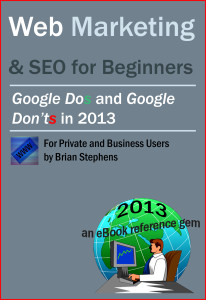Web marketing and SEO, is often a consideration that is made once the structure and aesthetics of a website design have been finalised. This is without doubt an error for anyone wishing to market their new website on the Internet via search engines.
SEO is also a constantly changing target and, for new webmasters, one which can be quite difficult to grasp, especially whilst trying to come to terms with all the other aspects of owning a new website. Compounding the problem is what appears to be Google’s war on anyone that tries to optimise their website so that it is more easily found by search engines and returned in their search results.
The truth is that Google and other search engines do appreciate the time and effort webmasters put into optimising their websites, but with a great big proviso! Which is that they do it by the rules, using white hat techniques, and do not try to game the system in an attempt to fool them into believing a website discusses topics outside their actual content or is more popular and useful than it actually is.
 To help new websmasters, I have written and published a Web Marketing & SEO for Beginners guide to the use of SEO (search engine optimisation) as an accompaniment to my first book on Website Design.
To help new websmasters, I have written and published a Web Marketing & SEO for Beginners guide to the use of SEO (search engine optimisation) as an accompaniment to my first book on Website Design.
It is a more in depth look at the SEO & marketing through the Internet side of things and it’s sub-title is very aptly called Google Dos and Google Don’ts. Quite simply because there are activities described that will help you in appealing to the search engine masters, i.e. search engine optimization they like, and other activities that most certainly will not help your cause and are more likely to result in your website being cast into eternal obscurity.
The main Topics Covered in the Web Marketing Guide
- Website copy and content
- Search Engine Accessibility
- Website Load Speeds
- Creating Great Content
- How Much Content is Enough Content
- Formatting and Layout of Content
- Keyword Optimisation
- Finding Keywords for Your Niche
- Meta Tags – Which Are Important?
- Sub-Domains or Directories
- Page Rank Sculpting
- Link building strategies
- Google Recommendations
- Article Marketing
- Guest Blogging and Posting
- Community Websites
- Reciprocal Linking
- Blog Commenting
- Forum Participation
- Buying Links
- Negative SEO
- Websites for Mobiles
- Website Performance Monitoring
- Social Media Signals
There is of course some overlap with the original web design guide because anyone considering web marketing, as mentioned previously, should be applying design features that account for SEO as the design is actually being developed.
Once the website is published on the Internet however, there is much more that can and needs to be done to ensure that the website can receive some free organic traffic via the search engines. There will always be people that game the system and if they can get away with it, who can blame them, it’s a very competitive world. But Google et al are becoming much more adept at spotting the techniques used and are putting a lot of resources into countering those techniques. The result is that the little fish who haven’t got the resources of large national companies often become collateral damage, sometimes because they just don’t know the difference between the right and wrong ways to optimise.
So now there is no excuse for a small fee you can use this concise guide to avoid the pitfalls that many new and even experienced webmasters fall into. You can buy the book here.

